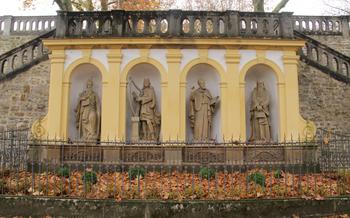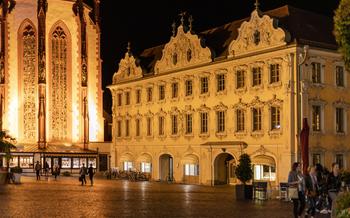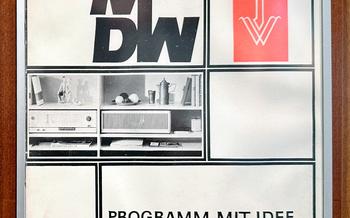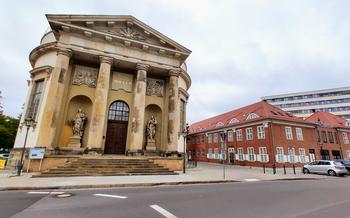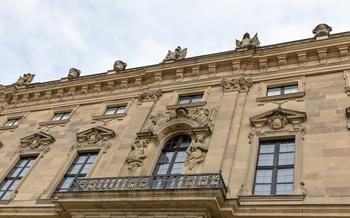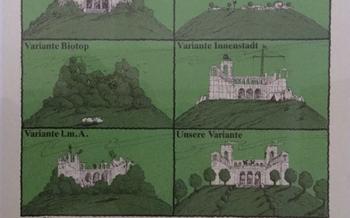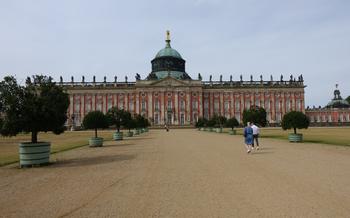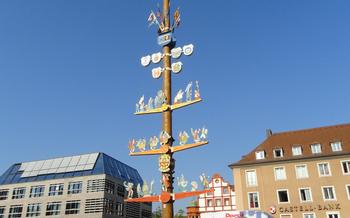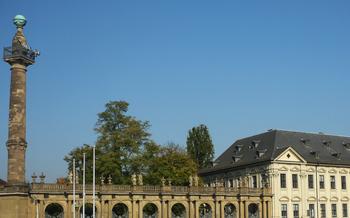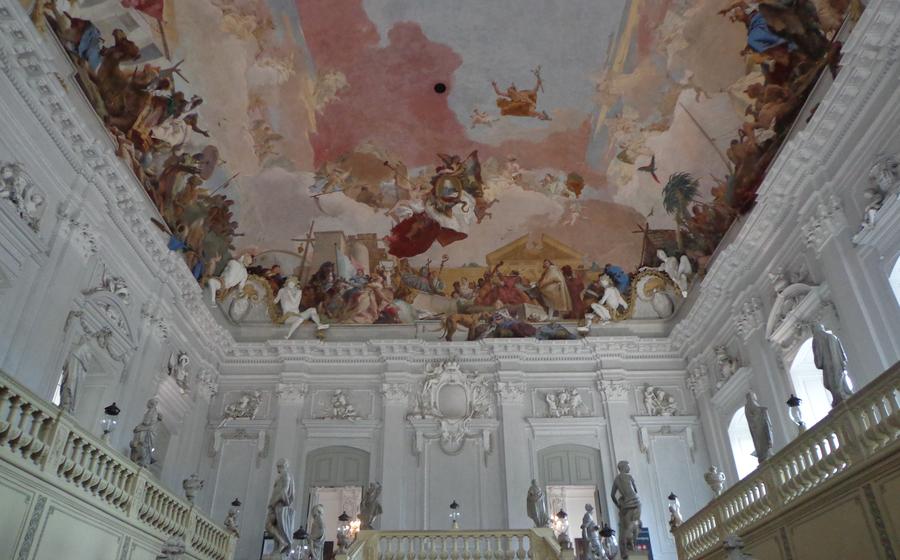
Treppenhaus der Residenz
- Balthasar Neumann's Masterpiece
- A Baroque Spectacle
- The curves of the staircase's balustrade and the sweeping lines of its handrails create a sense of movement and fluidity. The ornate carvings and sculptures that adorn the staircase add to its visual richness and complexity. The play of light and shadow created by the staircase's many windows and the interplay of light and dark colors further enhance the staircase's dramatic effect.
- The staircase's design is a masterpiece of Baroque architecture, embodying the era's love of grandeur, drama, and theatricality. It is a must-see for anyone interested in Baroque art and architecture, and it is sure to leave a lasting impression on all who visit it.
- A Symbol of Power and Prestige
- A Technical Marvel
- The Staircase in Art and Literature
- The Staircase as a Film Location
- The Staircase in Popular Culture
- The Staircase and the Local Community
- The Staircase and Education
- Conservation and Restoration
- Accessibility and Inclusivity
- Insider Tip: Unveiling the Staircase's Hidden Gems
Balthasar Neumann's Masterpiece
Balthasar Neumann, the architect behind the Treppenhaus der Residenz, was a true master of his craft. Born in Eger, Bohemia, in 1687, he received his architectural training in Prague before moving to Würzburg in 171Neumann's style was heavily influenced by the Baroque movement, characterized by its elaborate ornamentation, dramatic use of light and shadow, and fusion of architecture, sculpture, and painting.
Neumann's work in Würzburg is particularly noteworthy, and the Treppenhaus der Residenz stands as his crowning achievement. His other notable works in the city include the Residenz itself, the Käppele, and the Schönbornkapelle. These buildings showcase Neumann's unique blend of architectural styles, combining elements of Baroque, Rococo, and Classicism.
The Treppenhaus der Residenz exemplifies Neumann's artistic vision and technical prowess. The staircase's innovative design, with its seemingly unsupported arches and trompe l'oeil paintings, demonstrates Neumann's mastery of engineering and perspective. The staircase's intricate carvings, sculptures, and frescoes further enhance its visual appeal, creating a harmonious blend of architecture and art.
A Baroque Spectacle
The staircase's Baroque design is a masterpiece of theatricality and grandeur. The interplay of curves and straight lines creates a dynamic sense of movement and energy, while the elaborate ornamentation and use of light and shadow add to the dramatic effect. The staircase's design is a testament to the Baroque era's love of opulence and splendor.
The curves of the staircase's balustrade and the sweeping lines of its handrails create a sense of movement and fluidity. The ornate carvings and sculptures that adorn the staircase add to its visual richness and complexity. The play of light and shadow created by the staircase's many windows and the interplay of light and dark colors further enhance the staircase's dramatic effect.
The staircase's design is a masterpiece of Baroque architecture, embodying the era's love of grandeur, drama, and theatricality. It is a must-see for anyone interested in Baroque art and architecture, and it is sure to leave a lasting impression on all who visit it.
A Symbol of Power and Prestige
The grand staircase of the Prince-Bishop's Palace was not merely a functional element but a powerful symbol of the wealth, power, and prestige of the Prince-Bishops of Würzburg. It was designed to impress visitors and assert the authority of the prince-bishops, who ruled over a vast and influential territory in the Holy Roman Empire. The staircase served as a stage for elaborate ceremonies and diplomatic events, where the prince-bishops would receive guests, conduct official business, and display their opulence.
One notable anecdote illustrates the staircase's role in showcasing the prince-bishops' power. In 1746, the Russian Tsarina Elizabeth I sent a delegation to Würzburg to negotiate a trade agreement. The delegation was led by Count Ivan Chernyshev, a prominent diplomat and military commander. Upon arriving at the palace, Chernyshev was awestruck by the grand staircase. He later wrote in his memoirs that he had never seen anything like it, describing it as "a masterpiece of architecture and a testament to the power and glory of the Prince-Bishops of Würzburg."
The staircase's grandeur and opulence were not only meant to impress visitors but also to reinforce the prince-bishops' authority and legitimacy. By constructing such a magnificent staircase, the prince-bishops sought to demonstrate their wealth, their commitment to the Catholic Church, and their ability to provide stability and prosperity to their subjects. The staircase thus became a symbol of the prince-bishopric's political and religious importance, and a reminder of the power and influence of its rulers.
A Technical Marvel
The Grand Staircase of the Würzburg Residence is not just a Baroque masterpiece; it is also a testament to the engineering brilliance of its architect, Balthasar Neumann. Neumann, a master of illusion and trompe l'oeil, employed several innovative techniques to create the staircase's seemingly impossible design.
One of the most remarkable aspects of the staircase is its lack of visible supports. Neumann achieved this by using a series of hidden arches and vaults to distribute the weight of the staircase evenly. The arches are so cleverly concealed that they are virtually invisible to the naked eye, giving the illusion that the staircase is floating effortlessly in space.
Neumann also used trompe l'oeil painting to create the illusion of additional depth and grandeur. The ceiling of the staircase is painted with a series of receding arches, which makes the space appear larger than it actually is. The walls are decorated with illusionistic paintings of statues and balustrades, which further enhance the sense of depth and movement.
The construction of the staircase was not without its challenges. One of the biggest obstacles was the need to create a staircase that was both grand and structurally sound. Neumann solved this problem by using a combination of stone and wood. The main structure of the staircase is made of stone, while the steps and balustrades are made of wood. This combination of materials allowed Neumann to create a staircase that was both lightweight and strong.
The Grand Staircase of the Würzburg Residence is a true marvel of engineering. Neumann's innovative use of hidden arches, vaults, and trompe l'oeil painting created a staircase that is both visually stunning and structurally sound. It is a testament to Neumann's genius and his ability to push the boundaries of architectural design.
Anecdote:
During the construction of the staircase, Neumann faced a particularly challenging problem. The staircase needed to be built in a way that would not interfere with the existing windows and doors of the palace. Neumann solved this problem by designing the staircase in such a way that it would fit perfectly into the existing space. He used a series of curves and angles to create a staircase that was both functional and aesthetically pleasing. The result is a masterpiece of engineering that has been admired by visitors for centuries.
The Staircase in Art and Literature
The Treppenhaus der Residenz has been immortalized in various forms of artistic expression. It has been depicted in paintings, drawings, and photographs, and referenced in literature and poetry. One of the most famous depictions of the staircase is the painting "The Grand Staircase of the Residenz in Würzburg" by the German artist Johann Baptist Hofner. This painting, created in 1821, captures the staircase's grandeur and elaborate Baroque design.
In literature, the staircase has been featured in works by renowned authors such as Johann Wolfgang von Goethe and Theodor Fontane. In Goethe's novel "Wilhelm Meisters Lehrjahre," the protagonist is awestruck by the staircase's beauty and describes it as "a masterpiece of architecture." Fontane, in his travelogue "Wanderungen durch die Mark Brandenburg," praises the staircase as "one of the most magnificent staircases in all of Germany."
The staircase's iconic status has also made it a popular subject for contemporary artists and writers. In recent years, the staircase has been featured in several contemporary art exhibitions and has been the subject of numerous poems and short stories.
The Staircase as a Film Location
The Treppenhaus der Residenz's captivating visual allure has not gone unnoticed by the film industry. Its distinctive aesthetics have made it a sought-after filming location for movies and television shows. The staircase's grandiosity and intricate details provide a stunning backdrop for cinematic storytelling.
In the popular German television series "Babylon Berlin," the staircase served as a dramatic setting for a high-stakes poker game between rival factions. The opulent surroundings and the tension-filled atmosphere created a memorable scene that showcased the staircase's ability to transport viewers to a different time and place.
Another notable appearance of the staircase was in the 2015 film "Woman in Gold." The film tells the true story of Maria Altmann, an elderly Jewish woman who fought to reclaim her family's artwork stolen by the Nazis during World War II. In one poignant scene, Maria, played by Helen Mirren, stands at the foot of the staircase, contemplating the loss of her family's heritage and the enduring legacy of the Holocaust. The staircase's grandeur and historical significance added depth and emotional resonance to the scene.
Filmmakers are drawn to the Treppenhaus der Residenz not only for its visual appeal but also for its historical authenticity. The staircase's well-preserved condition and its status as a UNESCO World Heritage Site make it an ideal location for period dramas and historical films.
For filmmakers seeking a unique and visually stunning location, the Treppenhaus der Residenz offers a wealth of possibilities. Its architectural grandeur, historical significance, and cinematic potential make it a popular choice for filmmakers from around the world.
The Staircase in Popular Culture
The Treppenhaus der Residenz has transcended the realm of architecture and history to become an iconic symbol of Würzburg, recognized far beyond the confines of the city. Its unique beauty and historical significance have made it a popular subject for souvenirs and merchandise, ranging from postcards and magnets to replicas and miniature models. The staircase's distinctive silhouette has become synonymous with Würzburg, gracing countless travel guides, brochures, and promotional materials. Its enduring appeal has also made it a popular backdrop for movies, television shows, and music videos, showcasing its grandeur to a global audience. The staircase's presence in popular culture has further cemented its status as a beloved landmark and a source of pride for the people of Würzburg.
Anecdote:
In 2010, the renowned fashion designer Karl Lagerfeld visited Würzburg and was captivated by the Treppenhaus der Residenz. He was so impressed by its elegance and opulence that he decided to feature it in his next fashion show. Lagerfeld transformed the staircase into a runway, showcasing his latest collection against the backdrop of the magnificent Baroque masterpiece. The show was a resounding success, and the staircase received widespread recognition in the fashion world, further solidifying its status as a global icon.
The Staircase and the Local Community
The Treppenhaus der Residenz is not just a historical monument but also a beloved landmark that holds a special place in the hearts of the people of Würzburg. For centuries, it has been a source of civic pride, a gathering place for community events, and a symbol of the city's rich cultural heritage.
One of the most beloved traditions associated with the staircase is the annual "Treppenhausfest," a festival that takes place every summer on the staircase's grand landing. The festival features live music, dancing, food, and drinks, and attracts thousands of locals and tourists alike. It is a time for the community to come together, celebrate their heritage, and enjoy the beauty of this architectural masterpiece.
The staircase has also been featured in numerous local artworks, including paintings, sculptures, and photographs. It has been immortalized in literature and poetry, and has even served as the backdrop for several films and television shows. In short, the staircase is deeply intertwined with the cultural and social fabric of Würzburg, and is a source of inspiration and pride for its citizens.
Anecdote:
One of the most heartwarming stories about the staircase's connection to the local community involves an elderly woman named Frau Schmidt. Frau Schmidt had lived in Würzburg her entire life, and she had always loved the Treppenhaus der Residenz. She would often sit on the staircase's steps and reminisce about her childhood, when she would play hide-and-seek in its hidden corners.
One day, Frau Schmidt was diagnosed with a terminal illness. She knew that her time was limited, and she wanted to spend her remaining days doing the things she loved most. One of her wishes was to visit the Treppenhaus der Residenz one last time.
With the help of her family and friends, Frau Schmidt was able to make her wish come true. She was wheeled up the staircase in a wheelchair, and she sat on the landing, surrounded by her loved ones. She smiled as she looked around at the familiar surroundings, and she whispered, "This is where I belong."
Frau Schmidt passed away peacefully a few weeks later, but her memory lives on in the hearts of her family and friends. Her love for the Treppenhaus der Residenz is a reminder of the deep bond that exists between this architectural masterpiece and the people of Würzburg.
The Staircase and Education
The Treppenhaus der Residenz, with its architectural significance and historical allure, serves as a valuable educational tool for architecture and art history students. Universities and institutions incorporate the staircase into their curricula, organizing study tours and workshops that delve into its intricate details and Baroque grandeur. These academic visits provide students with an immersive experience, allowing them to analyze the staircase's design, construction techniques, and artistic elements firsthand.
The staircase's unique features, such as its innovative engineering solutions and elaborate ornamentation, offer a rich learning opportunity for aspiring architects and art historians. By studying the staircase, students gain insights into the architectural trends of the Baroque era, the creative genius of Balthasar Neumann, and the historical context in which the staircase was conceived.
Furthermore, the staircase's enduring legacy and its status as a UNESCO World Heritage Site make it a compelling case study for understanding the importance of cultural preservation and heritage management. Through research projects, dissertations, and academic publications, scholars continue to explore the staircase's multifaceted significance, contributing to a deeper understanding of its architectural, historical, and cultural dimensions.
Anecdote:
During an architecture seminar held at the staircase, a young student named Anna was particularly fascinated by the interplay of light and shadow within the grand space. Inspired by the staircase's design, she decided to pursue a master's degree in architectural lighting design, specializing in the use of natural light in historic buildings. Her passion for the staircase led her to a successful career in architectural lighting, where she now creates innovative lighting solutions for historic landmarks around the world.
Conservation and Restoration
The Treppenhaus der Residenz, like any historical monument, requires constant care and attention to preserve its grandeur for future generations. The passage of time, environmental factors, and the wear and tear of visitors can take their toll on the delicate frescoes, sculptures, and architectural elements that adorn the staircase.
Over the years, the staircase has undergone several conservation and restoration campaigns to ensure its structural integrity and maintain its original beauty. These efforts have involved a range of techniques, from cleaning and repairing the stonework to restoring the vibrant colors of the frescoes.
One of the most significant restoration projects was undertaken in the 1980s, when the staircase was meticulously cleaned and restored to its former glory. This involved removing layers of dirt and grime that had accumulated over the years, revealing the intricate details and vibrant colors that had been hidden beneath.
Another major conservation project was completed in 2018, when the staircase's elaborate wrought-iron railings were restored. The railings had suffered from corrosion and wear over the years, and the restoration involved carefully dismantling, cleaning, and repairing each individual element before reassembling them on the staircase.
These conservation and restoration efforts are essential to preserving the Treppenhaus der Residenz and ensuring that future generations can continue to appreciate its beauty and significance. They require a delicate balance between preserving the staircase's historical integrity and adapting it to modern needs, such as ensuring accessibility for visitors with disabilities.
One of the challenges in conserving the staircase is the need to strike a balance between preserving its historical integrity and adapting it to modern needs. For example, while the staircase was originally designed to be lit by candles, it is now illuminated by electric lights to ensure safety and accessibility for visitors.
Despite the challenges, the conservation and restoration efforts have been successful in preserving the Treppenhaus der Residenz as a magnificent example of Baroque architecture. The staircase continues to inspire awe and wonder in visitors from around the world, and it stands as a testament to the skill and artistry of its creator, Balthasar Neumann.
Accessibility and Inclusivity
In recognition of the importance of inclusivity, the Treppenhaus der Residenz has undergone modifications to ensure that visitors of all abilities can fully appreciate its grandeur. Ramps and elevators have been strategically installed to facilitate access for wheelchair users and individuals with limited mobility. These modifications have transformed the staircase into a welcoming space where everyone can marvel at its architectural wonders without barriers.
One heartwarming anecdote exemplifies the positive impact of these accessibility improvements. A visitor named Maria, confined to a wheelchair due to a spinal cord injury, expressed her gratitude for the thoughtful design considerations that allowed her to experience the staircase's beauty firsthand. "Before the accessibility modifications, I had resigned myself to the idea that I would never be able to see the Treppenhaus der Residenz," she recalled. "When I finally visited after the renovations, I was overwhelmed with emotion. It was a truly liberating experience to be able to navigate the staircase independently and appreciate its intricate details up close."
The success story of Maria's visit highlights the transformative power of accessibility. By embracing inclusivity, the Treppenhaus der Residenz has not only preserved its historical significance but has also become a symbol of equality and empowerment for visitors from all walks of life.
Insider Tip: Unveiling the Staircase's Hidden Gems
Beyond the grandeur and spectacle of the Treppenhaus der Residenz, there are hidden corners and secret spots that offer unique perspectives and unforgettable photo opportunities. One such spot is the small balcony overlooking the staircase. Accessible through a discreet door, this balcony provides a bird's-eye view of the elaborate Baroque masterpiece, allowing visitors to appreciate its intricate details and sheer scale.
For the best lighting conditions, plan your visit to the staircase around midday, when the natural light floods through the windows, casting dramatic shadows and illuminating the staircase's every nook and cranny. Alternatively, a visit at dusk can be equally rewarding, as the soft, golden light creates a warm and inviting atmosphere.
After your visit to the staircase, take some time to explore Würzburg's charming culinary scene. For a quick bite and a refreshing drink, head to Café Central, located just a stone's throw from the Residenz. This cozy café offers a delightful selection of homemade cakes, pastries, and sandwiches, perfect for a light snack or afternoon tea.
And if you're looking for a unique souvenir to remember your visit, make sure to stop by the Residenz Shop. This well-stocked shop offers a range of items inspired by the staircase, including postcards, posters, and even miniature replicas.
